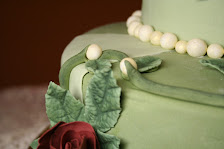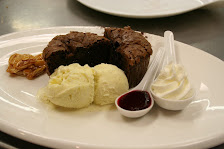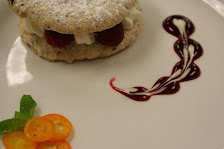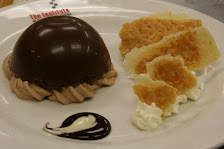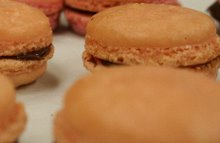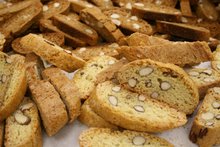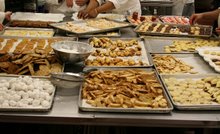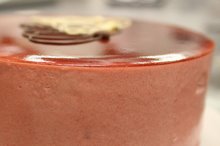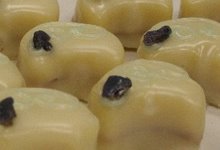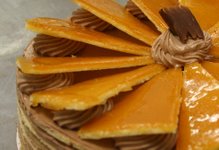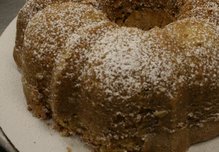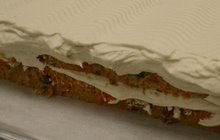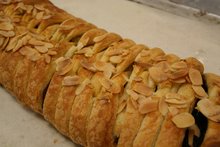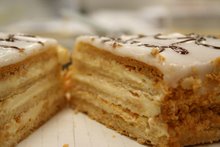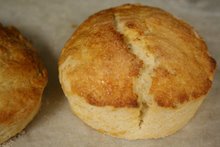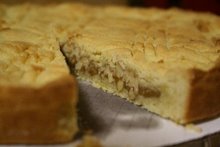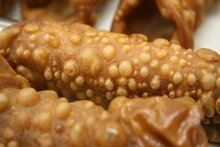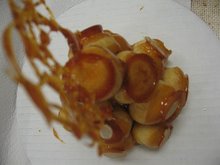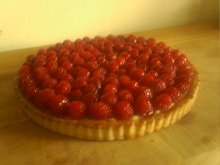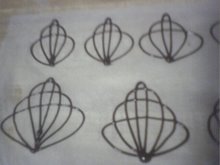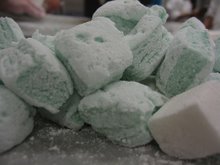Sunday, April 29, 2007
It would seem that we’re in the middle of the two-or-more-day-cake phase. These days it’s always make the cake layers, freeze them, come back again, and do something to them. This has its advantages though; imagine this: you’re cutting a cake. Horizontally. Would you rather do this when the cake is nice and soft, hot, tender, and fresh from the oven? Or would you rather do it when the cake is a solid and forgiving block of what is basically frozen butter with a little starch, sugar, and egg thrown in to keep up appearances? Me too. So let’s proceed with the understanding that these creations of ours can be accomplished by actual human beings, right in our own homes. The two-day aspect isn’t continuous, so don’t be daunted. It’s not quite a lot like painting your house.
The particular Two Day Cake we cranked out this week was a miroir (meer-WAHR). The miroir (“mirror”) is a classic French dessert composed of layers of sponge cake which are moistened with syrup, filled and iced with a bavarois, or Bavarian, and topped with a thin layer of nappage. For clarification, allow me to state that the Bavarian I’m talking about here isn’t a person dressed in short pants with suspenders and a jaunty little feathered cap. No, this is a different kind of polka-dancer, where a purée of fruit (or another base of similar texture) is mixed with gelatine, and then folded together with whipped cream. The tricky part is the folding. People are afraid of folding, and understandably so; if you do it too forcefully, whatever it is you’re folding will deflate. Why not simply do it slowly, then? The Bavarian is the perfect answer. The gelatine which is melted into the base must necessarily be slightly warm, while the cream must be at least cool. The trick in folding them together is to do it gently enough so that the whipped cream isn’t completely deflated, but quickly enough that the gelatine doesn’t set when it comes in contact with the cream. Failing to accomplish the latter would result in a creamy sludge with what would seem like Gummy Bear droppings scattered throughout it, and we clearly can’t have that. Nappage (nah-PAZH), from way back in our first week, is essentially jelly with extra pectin. To construct the cake, you place a layer of sponge in a cake ring (think cake pan without sides), moisten it, top it with Bavarian, another layer of cake, and so forth, ending with a perfectly even and smooth layer of Bavarian. You chill this until set, and then pour a pool of warm nappage on the top, creating the mirror effect for which the dessert is named. Using a cake ring is doubly exciting. Not only can you create a cake with tremendously even sides, but when the time to remove the ring has come, you get to blowtorch it until it’s loose enough to simply slip off.
Some people have issues with the Bavarian (which is, by the way, what Bavarian cream really is; that stuff in donuts is a lie). The texture, admittedly, is a little unconventional, being somewhere between mousse and Jell-O, and nothing goes worse with cake than Jell-O. It’s also understandably off-putting to consider a gelatinous dairy product. Once you get past these things, though, it’s a pretty enjoyable dessert. The one I fashioned was strawberry (and before you raise the hypocrite alarm, let me state that both the purée and the nappage were (presumably) made from fruit when it was in season), decorated on top with some more voluntary cornet work.
What’s happening to me!?
Monday, April 23, 2007
I’ll admit it: these haven’t been light little wisps of pastry we’ve been creating. You can, therefore, imagine my pleasure at finding that our most recent project was very different than the chocolate-cloaked-or-caramel-topped-or-sugar-enrobed-or-cream-cheese-infused items which we’ve been producing. We were finally introduced to the génoise, a classical French sponge cake which is always soaked with syrup during assembly. This cake is made by a whole lot of folding. Egg whites are whipped with a bit of sugar. Egg yolks are whipped with a bit of sugar. Dry ingredients, like flour, cornstarch, baking powder, and salt, are sifted together. The yolks are folded into the whites, and then the dry into the wet. That part (no fat other than egg yolks, did you notice?) people follow. It’s the whole syrup thing that sounds disagreeable when people first encounter it, but allow me to explain (as if you had a choice). Too much, yes – nasty, gross, soggy cake; who needs it? Too little, however, and you have an equally unappealing, dry layer which will make even the lactose-intolerant cry out for milk. Just the right amount, though, and you’re biting into a pastry that is the perfect (and I mean perfect) level of “moist,” that ever sought-after characteristic of cake. As with last week, we baked the layers with partners, but for the finishing we were left to our own devices; I chose raspberry. (Now, don’t think me some great hypocrite when it comes to seasonal fruit. We had to use something, and I chose raspberry. I’m not proud of it, but my pride does not extend to getting a failing grade for the day.) For the syrup, we used framboise, which is a raspberry eau-de-vie (a clear, unsweetened, 40% alcohol liquor distilled with the essence of a plant) combined with simple (sugar) syrup. After soaking the first layer, I topped it with pastry cream that had been scented with framboise as well, and dropped a few raspberries around in it. The second layer went on and got soaked. Then, the whole cake was iced with sweetened whipped cream, adorned with a few additional raspberries, and some sugared slivered almonds, just for some textural diversity. I will admit that when conceptualizing it, even I thought it would be overpoweringly raspberryish. It wasn’t though. It was airy and fruity and extremely cheerful. Like me, most of the time.
All balloons pop eventually. We countered this useless lightness with one of the heaviest and certainly best things so far, in the form of a chocolate chestnut cake. We soaked a layer of chocolate génoise with syrup flavored with kirsch, a cherry eau-de-vie (you couldn’t really taste the cherry, it just added depth; let’s move forward with that understanding). We then topped this first layer with alternating stripes of whipped ganache and chestnut buttercream. Other than that Christmas song, chestnuts don’t seem too popular here in good old America; they’re much more beloved in our parent England. In any case, they’re delightful, and one thing that further enhances their resident richness is to incorporate a puree of them into a buttercream. Trust me. The next layer of the cake was added and again soaked, and then, like that fancy cake of a few weeks ago, iced very evenly with whipped ganache. After chilling and firming, we poured liquid ganache over the whole thing, creating a shiny finish that’s only fitting for a cake this good. I decorated mine with some cornet work, and decided to further embellish it with a little gold dust. This was a mistake, because there was moving air in the room. Not only did some random current cause my first attempt to add a dot of it turn into a comet-shape (and therefore all subsequent ones, in an attempt to be consistent), but when someone walked by quickly, a whole random smattering of it landed elsewhere on my cake’s surface. Not to worry, it’s gold dust. It’s innately appealing.
And once they took a bite, I’m sure they all forgot.
Saturday, April 14, 2007
Days 58 and 59: Babies. Mamas.
If you enjoy getting your entire being sticky by covering it in repeated coatings of pasty, semi-liquid sugar which will promptly solidify on your skin and thereafter mercilessly rip out any hair that had the misfortune to have been in the spot where this tacky sludge was originally applied, you might consider making some petits fours glacés (petty four glah-SAY). These little treasures have the dual condition of being adored by the general populace and abhorred by their creators. The assembly isn’t so esoteric: make a couple of frangipane layers, chill them, sandwich them with some strained and therefore seedless raspberry jam, chill them some more, cut them (perfectly), chill them one more time, then glaze and decorate them. That’s ostensibly easy. The common glaze for these is poured fondant (don’t struggle with it, just say FOND-int; you’re American, and that’s okay), which is essentially sugar with a small amount of water (and sometimes corn syrup) added, and mixed into an opaque and pearl-colored sludge. Said sludge pours beautifully as long as it’s somewhere within the generous temperature range of about 110 to 111 degrees Fahrenheit. Okay, it’s a little more generous than that, but truthfully, not much, and the real kicker is that if you heat it over say 120 degrees, it becomes pretty much useless. Oh, and when it hits the low end of its temperature range, as mentioned, it turns into a kind of diabetic plaster. We were to create twelve identical (a word which many of the members of class seemed to define quite subjectively) petits fours, plate them, and present them to Chef for evaluation. While we worked with partners during the assembly phase, our glazing and decorating was our own. For my miniature crescents, I opted for a pale yellow glaze with (slightly too) pale green adornments, finished with a small section of crystallized violet petal (which are gaining their own special place in my heart). Lovely. And to think: one satisfying bite took merely three days to prepare. Nonetheless, petits fours glacés are the darlings of the pastry world; indeed, those acquaintances of mine with whom they were shared gave me genuine kowtows. In my opinion (which you’re getting anyway), fondant looks very pretty, but it tastes like plain sugar (which is probably due to the fact that it’s plain sugar; I can’t say for sure; I’m not a chemist). To have flavored it with some oil-of-something-or-other – lemon, for example – would probably have been prudent. The marriage of the frangipane’s velvety smoothness and the raspberry jam’s enlivening tartness was presided over by the priest of sugar, who, despite his shallowness, truly made the ceremony what it was. Like I said, lovely. Just sort of a pain in the butt. (Then, most worthy weddings are.)
I like to think that every little one, sweet and/or annoying, is followed at some point by a grande dame whose dignity commands naught but the highest respect of everyone who interacts with her. Whether this tenet holds true in the real world or not, it definitely did in our class. Our particular stroller-pusher was Hungarian, and she goes by the name of dobos torte (if you want to keep it simple, say DOH-bohs tort; if you want to sound more well-informed, try DOH-bohsh; it’s closer). If some old-timer came up to me and said “Sonny, this torte is the reason WWI happened in the first place,” I might have believed him (ignoring the fact that an old-timer using the word “torte” could be somewhat off-putting). An impractically thin layer of moist yellow cake is topped with chocolate buttercream. This is then repeated. It is then repeated again. And again. Once more, and again. One final time, and voilà, we’re not quite done. (And unless you’re actually in
Which was, as usual, totally worth it.
Sunday, April 1, 2007
Things are really starting to get out of hand. Cakes shouldn’t be this good; it’s just not fair. First, I suppose I should give you a little background. You know those shows on TV where they do the competitions and all these women from various parts of our probably too-large country coalesce for the purpose of seeing which person can make the best cake? When I watch those programs, I always feel encapsulated in a feeling I can only describe as a sort of nonviolent terror, and it’s a feeling that I reserve exclusively for these shows. I think they shouldn’t call them Who Can Make The Best Cake shows, but perhaps something more along the lines of Which Enormous Cake Can Hold The Most Objects competitions. Even as I walked past a darkened bakery window in Manhattan sometime between late last night and early this morning, I saw a large white cake (at least six inches high) topped with a rim of enormous (out-of-season) strawberries. I thought to myself, Do people really like eating whole strawberries at the back of a piece of cake? Well, do you? I don’t understand the appeal of having an entire Oreo sticking out from the top of an otherwise harmless piece of cake. People seem to confuse jabbing with decorating. (I hope I’m not being too snobby here, but is that elegant? Really?) In any event, Chef said that we weren’t going to be making any “diner cakes,” and it was at that moment that two things transpired within my mind. First, I found a name for this phenomenon, which has for so long repulsed me. Perhaps somewhat more significantly, though, I realized that I was not alone in finding these the-higher-the-better confections to be revolting. That promise laid before us, I began to believe that our quest to perfection in cake was on the right track. I suppose every great teacher says one thing that leaves a mark.
It dawns on me also that I should explain how we’re filling these cakes, since I’ve explained the later step of icing. We cut them in half and then spread frosting in between the layers. There.
We began the week with a cake that was positively transporting. We first baked some dense, fudgy chocolate cake (clearly, a good start). Now, you occasionally see recipes that would have you take these cake layers and fill and frost them with a dense chocolate frosting, and then glaze it with chocolate, and then decorate it with chocolate, and then possibly even serve it with a chocolate sauce, and call it something like Chocolate Death. Yes, we get it, people love chocolate; you’re reading from one such person even now. But the truth is that many people, even those who wouldn’t admit it, like me, find desserts of this kind to be too rich. Beyond being too rich, though, they fail also to treat the eater to the ethereally perfect balance of texture that a good cake has. Well, there are reasons we’re learning all this. We did Pretty Icing Lesson No. 2 with the lightest frosting possible: whipped cream. While there’s nothing wrong with clean, fresh, lightly sweetened whipped cream, no one on my team argued when we were assigned caramel whipped cream. In a nutshell, this is made by melting some sugar into caramel, then (very carefully) pouring some cream into it, chilling it, and whipping it up. Really simple, and beyond excellent. The resultant cake, which I suppose would be dense chocolate cake filled and iced with caramel whipped cream, was stupefyingly good. (Stupefyingly might not even be a word but it’s the only one that makes any sense.) When I brought this cake to work the following morning, it was like watching some sort of nature show. Not the kind where they’re all cute and cuddly, either, but more like one where the entire pack has been hunting unsuccessfully all summer, until this one particular day.
Don’t worry, bliss was soon supplanted as the ruling emotion in the class. We moved on to working with marzipan. Marzipan, which is a thick, sweet almond paste, can be sculpted into any shape which it will hold, barring natural disaster, indefinitely. When appropriately tinted, it can be used to create an infinite variety of decorations. We began with the most cliché design (and therefore the one we’ll need to know best): roses. My first try was less than triumphant, but on repeating it the second day I felt I had made enough progress to display a photograph. To do this, you flatten small balls of tinted marzipan on the table, further thinning the edges with the back of an immaculate spoon. You then filet the marzipan discs from the table with a sharp knife, and then roll each into a specific shape – the first of course being the center of the rose, with the petals following. It’s a good start.
We concluded the week with a cake that still cannot trump the aforementioned one in sheer eating pleasure, but whose appearance leapt far to the front of the elegance line. We used one batch of ganache for two different tasks – icing and glazing. We each took about half of our barely cooled, still liquid ganache, and whipped it. We used this whipped ganache to fill our yellow cake layers and to ice the tops and sides of our cakes. After letting the cakes solidify in the freezer, we reheated the now cooled remaining half of our ganache to a liquid consistency, and proceeded to pour it over them, enrobing them entirely in a satiny, mirror-finish layer of sumptuous dark chocolate. Combined with a bit of cornet work, some chocolate shavings, a little gold leaf, and a ribbon, I produced my first cake of showpiece appearance. I brought this one, too, into work the following morning. It was greeted with oohs and aahs and many declarations that it looked “too good to eat.”
How quickly our convictions crumble.



